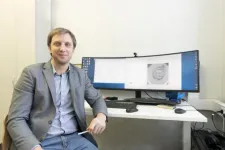(Press-News.org) The claim that old-growth forests play a significant role in climate mitigation, based upon the argument that even the oldest forests keep sucking CO2 out of the atmosphere, is being refuted by researchers at the University of Copenhagen. The researchers document that this argument is based upon incorrectly analysed data and that the climate mitigation effect of old and unmanaged forests has been greatly overestimated. Nevertheless, they reassert the importance of old-growth forest for biodiversity.
Old and unmanaged forest has become the subject of much debate in recent years, both in Denmark and internationally. In Denmark, setting aside forests as unmanaged has often been argued to play a significant role for climate mitigation. The argument doesn't stand up according to researchers at the University of Copenhagen, whose documentation has just been published as a commentary in Nature.
The entire climate mitigation argument is based upon a widely cited 2008 research article which reports that old-growth forests continue to suck up and sequester large amounts of CO2 from the atmosphere, regardless of whether their trees are 200 years old or older. UCPH researchers scrutinised the article by reanalysing the data upon which it was based. They conclude that the article arrives at a highly overestimated climate effect for which the authors' data presents no evidence.
"The climate mitigation effect of unmanaged forests with trees more than 200 years old is estimated to be at least one-third too high--and is based solely upon their own data, which, incidentally, is subject to great uncertainty. Thus, the basis for the article's conclusions is very problematic," explains Professor Per Gundersen, of the University of Copenhagen's Department of Geosciences and Natural Resource Management.
An unlikely amount of nitrogen
The original research article concluded that old-growth forests more than 200 years old bind an average of 2.4 tonnes of carbon per hectare, per year, and that 1.3 tonnes of this amount is bound in forest soil. According to the UCPH researchers, this claim is particularly unrealistic. Carbon storage in soil requires the addition of a certain amount of externally sourced nitrogen.
"The large amounts of nitrogen needed for their numbers to stand up don't exist in the areas of forest which they studied. The rate is equivalent to the soil's carbon content doubling in 100 years, which is also unlikely, as it has taken 10,000 years to build up the soil's current carbon content. It simply isn't possible to bind such large quantities of carbon in soil," says Gundersen.
Trees don't grow into the sky
Unlike the authors of the 2008 article, and in line with the classical view in this area, the UCPH researchers believe that old unmanaged forests reach a saturation point after a number of years. At that point, CO2 uptake ceases. After longer periods (50-100 years in Denmark) of high CO2 sequestration, storage decreases and eventually come to a stop. This happens when a forest reaches an equilibrium, whereby, through the respiration of trees and degradation of organic matter in the soil, it emits as much CO2 into the atmosphere as it absorbs through photosynthesis.
"As we know, trees don't just grow into the sky. Trees age. And at some point, they die. When that happens, decay begins, sending carbon back into the atmosphere as CO2. Other smaller trees will then take over, thereby leaving a fairly stable CO2 stock in the forest. As trees age, the risk of a forest being impacted by storms, fire, droughts, disease, death and other events increases more and more. This releases a significant portion of the stored carbon for a period of time, until newer trees replace the old ones," explains Gundersen.
He adds that the 2008 article does not document any mechanism which allows the forest to keep sequestering CO2.
The UCPH researchers' view is supported by observations from Suserup Forest, near Sorø, Denmark, a forest that has remained largely untouched for the past century. The oldest trees within it are 300 years old. Inventories taken in 1992, 2002 and 2012 all demonstrated that there was no significant CO2 uptake by the forest.
Old-growth forest remains vital for biodiversity
"We feel a bit like the child in the Emperor's New Clothes, because what we say is based on classic scientific knowledge, thermodynamics and common sense. Nevertheless, many have embraced an alternative view--and brought the debate to a dead end. I hope that our contribution provides an exit," says Per Gundersen.
He would like to make it clear that this should in no way be perceived as a position against protection of old-growth forest or setting aside unmanaged forest areas.
"Old-growth forest plays a key role in biodiversity. However, from a long-term climate mitigation perspective, it isn't an effective tool. Grasping the nuance is important so that debate can be based upon scientifically substantiated assertions, and so that policy is not influenced on an incorrect basis," concludes Gundersen.
INFORMATION:
ABOUT THE STUDY:
* The analysis was conducted by Per Gundersen, Emil E. Thybring, Thomas Nord-Larsen, Lars Vesterdal, Knute J. Nadelhoffer and Vivian K. Johannsen from the Department of Geosciences and Nature Management at the University of Copenhagen.
* The commentary has been published in the prestigious journal Nature and can be accessed here: https://www.science.ku.dk/english/press/news/2021/new-documentation-old-growth-forest-carbon-sinks-overestimated/
One big challenge for the production of synthetic cells is that they must be able to divide to have offspring. In the journal Angewandte Chemie, a team from Heidelberg has now introduced a reproducible division mechanism for synthetic vesicles. It is based on osmosis and can be controlled by an enzymatic reaction or light.
Organisms cannot simply emerge from inanimate material ("abiogenesis"), cells always come from pre-existing cells. The prospect of synthetic cells newly built from the ground up is shifting this paradigm. However, one obstacle on this path is the question of controlled division--a requirement for having "progeny".
A team from the Max Planck Institute for Medical Research in Heidelberg, Heidelberg ...
The team of researchers at Kaunas University of Technology (KTU), Lithuania applied artificial intelligence (AI) methods to evaluate data of human embryo development. The AI-based system photographs the embryos every five minutes, processes the data of their development and notifies any anomalies observed. This increases the likelihood of choosing the most viable and healthy early-stage embryo for IVF procedures. The innovation was developed in collaboration with Esco Medical Technologies, a manufacturer of medical equipment.
Almost one in six couples face infertility; about 48.5 million couples, 186 million individuals worldwide are inflicted. Europe has one of the lowest birth rates in the world, with an average of just 1.55 children per woman.
The most effective form of ...
By offering a microscopic "tightrope" to cells, Virginia Tech and Johns Hopkins University researchers have brought new insights to the way migrating cells interact in the body. The researchers changed their testing environment for observing cell-cell interaction to more closely mirror the body, resulting in new observations of cells interacting like cars on a highway -- pairing up, speeding up, and passing one another.
Understanding the ways migrating cells react to one another is essential to predicting how cells change and evolve and how they react in applications, such as wound healing and drug delivery. In a study published in the Proceedings of the National Academy of Sciences, a team formed by Mechanical Engineering Associate ...
Scientists of Tomsk Polytechnic University jointly with colleagues from different countries have developed a new sensor with two layers of nanopores. In the conducted experiments, this sensor showed its efficiency as a sensor for one of the doping substances from chiral molecules. The research findings are published in Biosensors and Bioelectronics (IF: 10,257; Q1) academic journal.
The material is a thick wafer with pores of 20-30 nm in diameter. The scientists grew a layer of metal-organic frameworks (MOF) from Zn ions and organic molecules on these thick wafers. The MOF has about 3 nm nanopores only. It plays the role of a trap for molecules, which must be detected.
"This sensor can operate with chiral molecules. Such substances consisting of chiral molecules are a lot among medical ...
In the future, photovoltaic cells could be "worn" over clothes, placed on cars or even on beach umbrellas. These are just some of the possible developments from a study published in Nature Communications by researchers at the Physics Department of the Politecnico di Milano, working with colleagues at the University of Erlangen-Nuremberg and Imperial College London.
The research includes among its authors the Institute of Photonics and Nanotechnology (IFN-CNR) researcher Franco V. A. Camargo and Professor Giulio Cerullo. It focused on photovoltaic cells made using flexible organic technology. Today's most popular photovoltaic cells, based on silicone technology, are rigid and ...
The Miscanthus genus of grasses, commonly used to add movement and texture to gardens, could quickly become the first choice for biofuel production. A new study shows these grasses can be grown in lower agricultural grade conditions - such as marginal land - due to their remarkable resilience and photosynthetic capacity at low temperatures.
Miscanthus is a promising biofuel thanks to its high biomass yield and low input requirements, which means it can adapt to a wide range of climate zones and land types. It is seen as a viable commercial option for farmers but yields ...
Energy models are used to explore different options for the development of energy systems in virtual "laboratories". Scientists have been using energy models to provide policy advice for years. As a new study shows, energy models influence policymaking around the energy transition. Similarly, policymakers influence the work of modellers. Greater transparency is needed to ensure that political considerations do not set the agenda for future research or determine its findings, the researchers demand.
Renewable energies bring many changes, including fluctuations in the energy supply and a more geographically distributed generation system. ...
A collaborative research project by team of undergraduate students from the University of Exeter's Natural Sciences department has been published in a prestigious academic journal.
Lewis Howell, Eleanor Osborne and Alice Franklin have had their second-year research published in The Journal of Physical Chemistry B.
Their paper, Pattern Recognition of Chemical Waves: Finding the Activation Energy of the Autocatalytic Step in the Belousov-Zhabotinsky Reaction, was a result of their extended experiment work in the Stage 2 module "Frontiers in Science 2".
Their project involved the Belousov-Zhabotinsky chemical reaction - an ...
March 7, 2021, KAUST, Saudi Arabia - KAUST Assistant Professor of Computer Science Mohamed Elhoseiny has developed, in collaboration with Stanford University, CA, and École Polytechnique (LIX), France, a large-scale dataset to train AI to reproduce human emotions when presented with artwork.
The resulting paper, "ArtEmis: Affective Language for Visual Art," will be presented at the Conference on Computer Vision and Pattern Recognition (CVPR), the premier annual computer science conference, which will be held June 19-25, 2021.
Described as the "Affective Language for Visual Art," ArtEmis's user interface has seven emotional descriptions on average for each image, bringing the total count to over 439K emotional-explained attributions from humans on ...
While urban agriculture can play a role in supporting food supply chains for many major American cities -- contributing to food diversity, sustainability and localizing food systems -- it is unrealistic to expect rooftop gardens, community plots and the like to provide the majority of nutrition for the population of a metropolis.
That's the conclusion of a team of researchers who analyzed the nutritional needs of the population of Chicago and calculated how much food could be produced in the city by maximizing urban agriculture, and how much crop land would be needed adjacent to the city to grow the rest. The study was the first to evaluate land required to meet ...



